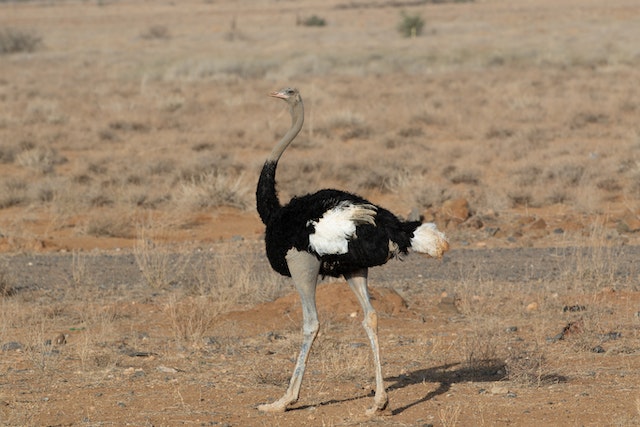
Why do ostriches have two kneecaps? It (possibly) helps them to run faster.
What does a kneecap do? The knee is basically a lever and the kneecap is the pivot point. In humans, the knee is the joint between the femur (thighbone) and the tibia (shinbone). The muscle on the front of the thighbone is called the quadriceps muscle. It is connected to the tibia by the patellar tendon. To lift your lower leg, you contract the quadriceps and it pulls the tendon, pulling up the lower leg. It is a basic lever. Now, the patellar tendon crosses the knee on the front of the knee cap. It does this for two reasons. The first reason is leverage. The kneecap isn’t very thick, but it gives enough distance to make it much easier for the quadriceps muscle to pull up the leg. Without the kneecap, it would be the same as trying to open a door with the door handle very close to the hinges. The kneecap makes the quadriceps muscle 30% more effective. The second reason is friction. The kneecap keeps the tendon away from the knee joint, where it would rub. The kneecap slides on a layer of cartilage, reducing friction and making it easier to lift the lower leg. Without a kneecap over our knee joint, we would have a lot more trouble walking.
Before we talk about why ostriches have two kneecaps, we need to think about where their knees actually are. When you look at an ostrich, their leg bends backwards in the middle. This looks like their knee, and people wonder why ostriches’ knees bend backwards, but this is not a knee. It is an ankle. Ostriches are digitigrade animals, which means they walk on their toes, or their digits. They are the same as cats and dogs. We are plantigrade animals, which means we place all of our feet on the floor when we walk. Digitigrade animals walk with their digits, but don’t use the soles of their feet, such as dogs and cats. Unguligrade animals walk on their tiptoes, and often they have hooves, such as deer and horses.
The ostrich is a digitigrade animal which means what looks like the ostriches’ feet are its toes. The main bone in the foot, the tarsometatarsus, looks like its lower leg and its ankle looks like a knee. Its knee is hidden under its wing, up by its rib cage. The ostrich has a short thigh bone that is connected to the knee joint. Their hip joint is at the other end of the short thigh.
Ostriches don’t just have a single kneecap like we do. They have two kneecaps, and upper and a lower one. The upper kneecap is very similar to ours and almost all other animals that have knees. The lower kneecap is the unusual one. It is a fixed, bony structure, very similar to our elbow.
So, why do ostriches have two kneecaps? There are possibly two reasons. The first reason is to spread out the stress on the tendon. Ostrich knees undergo tremendous forces and tendons can be crushed or even shear if the forces get too high. The placing of the kneecaps spreads out the forces and lowers the risk of injury.
The second reason is so that they can run faster. Our kneecap serves to move the tendon away from the knee joint and make lifting the lower leg easier. The kneecap of an ostrich seems to do the opposite. The placing of the upper kneecap reduces the amount of leverage, which doesn’t seem like a good idea until you see that it increases the speed with which the ostrich can straighten its leg. Animals that run fast need to have a long stride and they need to have a high frequency of steps. Ostriches have long legs and their stride when running is about 5 meters. The placing of their second kneecap lets them flick their leg out very quickly, which increases the frequency of their steps and is why they can run at 70 km/h.
There are three other reasons why ostriches can run so fast, and it is not to do with their knees. The first is the ligaments in their legs don’t allow their joints to move from side to side. When we run, we have to expend energy making sure our hips don’t move too far to the side. Ostriches don’t have this problem, so they have more energy to devote to speed. The second reason is the ligaments and tendons keep the ostriches leg extended when relaxed. That means they can stand up without expending any energy and they can use the ligaments almost like springs when they run. They use energy to compress the ligament and then the ligament springs back out. They can run fast without expending a lot of energy using this method. And the third reason is their claw. Ostriches have only two toes: a big one and a small one. When they walk, the claw on the big toe is raised, but when they run, it hammers into the ground with each step for grip. Extra grip means extra speed. And this is what I learned today.
Sources
https://animaldiversity.org/collections/mammal_anatomy/running_fast/
https://www.ncbi.nlm.nih.gov/pmc/articles/PMC5830293/
https://www.saintlukeskc.org/health-library/kneecap-patella-and-knee-joint
https://www.discoverwildlife.com/animal-facts/birds/why-do-ostriches-have-two-kneecaps/
https://www.sciencedaily.com/releases/2017/07/170703083313.htm
https://www.earth.com/news/ostriches-double-kneecap/
